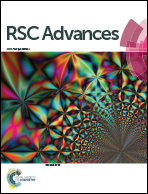Acyl transfer reactions of carbohydrates, alcohols, phenols, thiols and thiophenols under green reaction conditions†
Abstract
Acyl transfer reactions of various carbohydrates, alcohols, phenols, thiols and thiophenols were achieved at room temperature in high yields and catalytic efficiency in the presence of methane sulfonic acid, a green organic acid, under solvent-free conditions over short time periods. The method is mild enough to allow acid labile substituents such as isopropylidene acetals and trityl ethers on the reacting substrates to be left completely unaffected. Esterification of free mono- and dicarboxylic acids such as acetic acid, cinnamic acid, sialic acid and tartaric acid with alcohols such as menthol, ethanol, methanol or propylene glycol has also been achieved efficiently at room temperature. A comparative study of the method with the silica-sulfuric acid is also reported.


 Please wait while we load your content...
Please wait while we load your content...